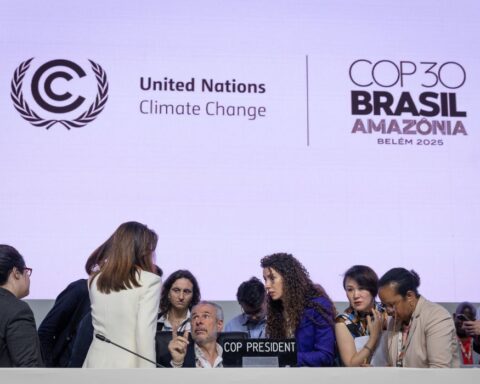In view of the steep costs that wildfires are exacting on Canada’s economy, six national organizations have come together to ask the federal government to invest more in wildfire defence and create a national fire administration to help coordinate operations.
In an open letter, the alliance of groups spanning diverse sectors makes the case for a “national resilience package” worth $4.1 billion over five years, starting with $820 million for the 2026 financial year. “These investments would save lives, protect the economy, reduce emissions, and strengthen community resilience,” the letter states.
The requested funding would cover increased surveillance and monitoring infrastructure, shared fire-suppression capacity between First Nations and different levels of government, and greater investments in training and equipment.
The campaign was spearheaded by the Council for Clean Capitalism – a multi-industry group coordinated by Corporate Knights since 2012 – and signed by the Canadian Association of Fire Chiefs, Nature Canada, Ducks Unlimited Canada, the Mining Association of Canada, Protect Our Winters Canada and World WIldlife Fund Canada.
“What makes this funding request different from other federal investments in wildfire equipment, training and resilience over the past few years, is the capacity to coordinate these funds in the most appropriate fashion and engage the local fire departments who must respond to fires in their communities,” says Tina Saryeddine, executive director of the Canadian Association of Fire Chiefs.
Multiple government departments and offices were contacted for comment on the letter. The Department of Finance declined to comment on what may be included in the 2025 budget.
Natural Resources Canada (NRCan) wrote in an email that “Wildfires are a global problem, directly attributed to the impacts of climate change, including prolonged drought.” The department says it has committed $800 million for wildland fire resilience since 2019, including $463 million for initiatives announced in the last two years, including $254 million for a multi-year equipment fund.
Through the Canadian Council of Forest Ministers, NRCan says it is working in partnership with provinces and territories to advance a wildland fire-prevention and mitigation strategy that serves as “whole of society approach to reduce wildfire risk and build safer, more resilient communities.”
The scale of the challenge
Canada is already spending heavily on wildfire suppression: more than $1 billion every year, with indirect costs adding another $500 million to that.
But the signatories argue that Canada must dramatically step up its spending if it hopes to respond adequately to the continued increases in wildfire intensity. “Meeting this challenge requires multi-billion-dollar, capital-intensive commitments in surveillance, suppression, and training – not incremental dollars,” the letter states. “Without this scale of investment, suppression capacity will continue to be outstripped by climate-driven fires.”
According to wildfire expert Mike Flannigan, wildfire severity and frequency have quadrupled since the 1970s. Roughly 8% of Canada’s forests have burned since 2023.
Canada’s forests are on fire. Where are the next generation of Canada’s water bombers?
– John Gradek, lecturer, McGill University
The research group at Corporate Knights estimates that wildfires have caused more than $30 billion in economic damages over the past five years, including business losses, property destruction and health system impacts. In 2023, during the most destructive fire season on record, 98% of Canadians were exposed to hazardous “smoke days” from wildfires. During that year in Ontario alone, health damages surpassed $1 billion in a single week.
Canadian wildfires also contribute substantially to global warming, with wildfire emissions now averaging 600 million tonnes annually, according to calculations by Corporate Knights researchers. Much of those emissions come from peatlands that release ancient carbon when they burn, accelerating climate change.
Canada’s fire funding
Canada’s capacity to fight wildfires is stretched thin. For significant parts of the 2023 and 2025 fire seasons, Canada was at National Preparedness Level 5 (NPL5), meaning that nearly all of the country’s domestic resources were maxed out.
The federal government’s recent investments in fighting wildfires have been comparatively small, despite the severe strain on firefighters, who say that they are understaffed and overworked and that they lack adequate equipment like water bombers. A Toronto Star investigation found that there are 100 fewer wildfire fighters in Ontario than there were 10 years ago.
“As resources dwindle, you just kind of start getting into that mindset of like, ‘OK, well, we have to figure out a way to make this work,’” Noah Freedman, a wildfire crew leader in northwestern Ontario, told CBC in July. “And the more we do that, the more we kind of push those limits, especially with the lack of experience that we have – that’s when mistakes start happening.”
In March, the federal government announced a $16.3-million investment over the next three years to train firefighters under its Fighting and Managing Wildfires in a Changing Climate (FMWCC) program. The new funding covers 25 projects across the country.
Wildfire season used to last three or four months, but the drier, hotter, windier conditions associated with climate change have extended it.
– Marco Lizotte, wildland firefighter
FMWCC was launched in 2022 with $346.1 million over five years, and all that money has been awarded. Likewise, Natural Resources Canada launched a Wildfire Resilient Futures Initiative in 2023 that was worth $285 million, which has also already been awarded.
The Emergency Management Assistance Program has a funding stream called FireSmart, which provides money to First Nations to help them prevent and prepare against wildland fires.
Areas of investment
Among the recommendations in the letter, the signatories are seeking $400 million over five years to improve wildfire surveillance. While Canada will launch a dedicated satellite for this purpose in 2029, a complementary and continuous surveillance layer is also required, they argue. Such a system would include wildfire detection drones, high-frequency satellite feeds and support for Indigenous fire guardians.
The Canadian Association of Fire Chiefs emphasizes the importance of establishing a national fire administration that would “integrate fire and life safety considerations into federal policy, strengthen prevention, and improve the federal response to emergencies.” Such an administration would complement rather than replace the existing Canadian Interagency Forest Fire Centre, whose role is to coordinate wildfire agencies at the provincial and territorial level.
The groups signed on to the letter are also seeking $2.5 billion over five years to expand and modernize aerial and ground fleets. “Canada’s forests are on fire. Where are the next generation of Canada’s water bombers?” says John Gradek, a lecturer on aviation management at McGill University, in an email. “Production stopped in 2016 . . . leaving us with an aging fleet ill-suited for today’s wildfire demand. We need 40 to 50 new water bombers to meet the scale and severity of modern wildfire seasons.”
RELATED
Canada needs strong climate policy to be competitive beyond the U.S.
Canada’s finance regulator says up to $1 trillion in lending could be unlocked
Defying Trump, investors boost renewables as they recoil from fossil fuel stocks
The letter also seeks investment of $1.2 billion over five years to scale up training and equipment programs. New recruits face physical dangers and extreme conditions.
“The expectations on Canada’s firefighters have risen dramatically in the last decade,” writes Marco Lizotte, a wildland firefighter in Northern Ontario, in an account for Maclean’s. “Wildfire season used to last three or four months, but the drier, hotter, windier conditions associated with climate change have extended it.”
A separate delegation unrelated to the letter campaign is travelling to Ottawa to call for stronger wildfire response, Marco Chown Oved reports in the Toronto Star. “These are not the kind of fires we used to fight,” Adam Lynes-Ford, who is leading the delegation, said. “These are fires of a different scale. This is a challenge of a different scale. We need a different-scale approach.”
*Updated with comments from Natural Resources Canada
** This article was amended to include the Canadian Association of Fire Chief as signatories to the campaign, as well as a quote by executive director Tina Saryeddine and more information about the proposed national fire administration.
Mark Mann is the managing editor at Corporate Knights. He is based in Montreal.
The Weekly Roundup
Get all our stories in one place, every Wednesday at noon EST.







